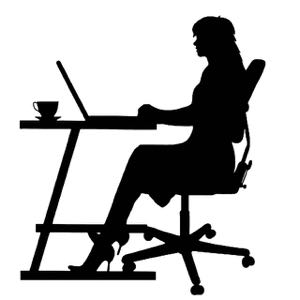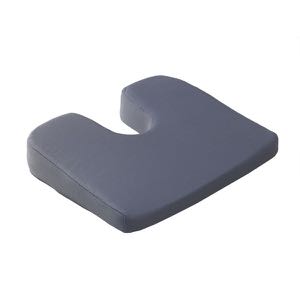by Luisito E. Batongbakal Jr.
We’ve all heard about the evils of prolonged sitting: The longer you sit, the higher your chance of suffering lower back pain.
Not surprisingly, almost every corner of the Internet is advocating the use of standing desks to curb occupational back pain. It’s true that standing can help break up all that sitting, and is a good way to get you moving more during the day, but recent research has suggested that standing all the time isn’t the best solution either. After awhile, it can cause foot, knee, and hip problems, as well as lead to lower back pain.
The answer lies in combining the two. Stand for a while, and then sit for a while, and most importantly, walk around in between! That means we need to make sure that while we’re sitting, we’re not creating back problems. (This is important while standing too, but that’s for another post.)
Listed below are some tips for how writers can prevent and relieve back pain while sitting. Take note, however, that these may work only for those whose back pain is directly caused by too much sitting in front of the computer. Talk to your physician to rule out any possible underlying medical conditions.
 1. Sit smarter, not harder.
1. Sit smarter, not harder.
Sitting, just like smoking, is a habit. And as discussed by Nebraska-based chiropractor Scott Donkin in his TED talk, it can either be a good or bad habit depending on what you know about body mechanics.
So, what constitutes a good sitting habit?
The body has a natural S-shaped curvature. The lower back curves inward, followed by a counterbalancing curve in the mid-back, terminating in a forward curve in the neck. As long as you keep these curves when sitting (or buy an ergonomic chair that follows the shape of your spine), you’ll reduce your risk of suffering pain.
The problem is, humans tend to go against their primal posture. We often slump when sitting, a bad habit further reinforced by poorly designed chairs that do nothing to support the spine. As a result, the muscles and connective tissues around the spine become weaker, increasing pressure on the vertebrae and leading to low back pain.
In addition to investing in a quality chair (see “What Smart Writers Spend Their Money On” for more), you can practice other exercises and stretches that help you sit without pain. The goal is to strengthen your “core”—the muscles supporting your spine.
Back to basics. Although the spine has natural curvature, we tend to slump forward when sitting, throwing our shoulders and back off balance. The remedy can be as simple as placing a cushion or rolled-up towel between your lower back and the back of the chair. By doing so, you prevent yourself from reverting to the same bad posture again. And by correcting your low back curvature, the neck and shoulders will naturally follow suit.
Computer ergonomics. By adjusting your body’s position relative to the computer and the desk, you can easily avoid work-related strains and back pain. Ideally, the computer screen should be at your eye level or slightly below it. The height of the desk and your chair should also allow your forearms to rest at a 90-degree angle. Lastly, your feet must be flat on the floor with your back resting comfortably to the chair.
 2. Desk-based stretches.
2. Desk-based stretches.
When a writer puts her heart and soul into her writing, it’s easy to forget to take a breather. Sitting in the same position for hours on end, also known as “static sitting,” often leads to low back pain. On the contrary, dynamic sitting promotes blood circulation in your back muscles and lubricates your spinal joints.
The key is to change positions or do simple stretches for at least five minutes every hour. Renowned physiotherapist Judith Gould recommends the following low back stretching exercises for writers and other desk-based workers:
- Lower spine stretch. While in a sitting position, raise your left hand above your head and bend your spine to the right. Hold for 30 seconds as you breathe deeply. Do it three times and then repeat on the other side.
- Long spinal stretch. This exercise decompresses your spine and spinal muscles by stretching them forward. Start by sitting up straight. Slowly slide your hands to your thighs all the way down to your feet and the floor. Hold for 30 seconds. Repeat it three times.
- Deep hip muscle stretch. By stretching your hip muscles, you’re also lengthening the leg and back muscles that are attached to it. Raise your right ankle and rest it across your left thigh. Keep your spine straight and feel the stretch in your right hip. Hold for 30 seconds and do it three times. Repeat on the opposite side.
- Hamstrings reach. Located at the back of your legs, your hamstring muscles, when tight, can distort the natural curvature of your spine. To loosen them up, start by sliding one foot forward until your knee is straight and the toes pulled toward the shin. With both hands, reach forward for your toes. Hold for 30 seconds and do it three times. Repeat on the other side.
 3. Chair yoga.
3. Chair yoga.
In addition to stretching, chair yoga also involves tuning into your breathing, which then allows you to become more aware of your body. It has elements of balance, strength, and alignment, all of which lead to a holistic healing of your back.
In a recent study published in the Annals of Internal Medicine, 320 adult participants were assigned to three groups: the first received 12 weekly yoga sessions, the second went into a 12-week physical therapy program, and the last one was given educational materials about back pain therapy.
Upon evaluation, almost half of the yoga and physical therapy groups reported reduced pain and disability, a positive result that remained the same one year later. The education group, however, didn’t improve as much: about a fifth reported improved function and only 14 percent noticed significant back pain relief.
In as little as five minutes, you can enjoy the benefits of yoga in the comfort of your own chair. Here are some stretches specifically designed for anyone who spends most of the day sitting:
- Backbend arch. While seated at the edge of the chair (preferably one without arms), place your hands behind you with fingers facing away from your hips. Arch your back forward to “open up” your body from the abdomen all the way up to your chest. Hold and breathe up to 10 times before releasing. This pose is essential for training your lower back to follow its natural curve, strengthening back muscles, and helping you breathe more deeply.
- Seated cat-cow. Through extension and flexion, this chair yoga pose promotes mobility of both the spine and hip sockets, which usually get stiff due to long periods of sitting. Sit at the front of the chair and put your hands on your knees. Inhale and lift your chest forward while sticking your hips out behind you. Allow your head and neck to lengthen out and back. As you exhale, move the back of your waist backward, round your chest, and drop your chin towards the chest. Repeat the steps until your complete 10 cycles.
- Lower-back circles. Sit with your feet hip-width apart and your hands resting on your knees. Rotate your torso by the base of the spine in a clockwise direction, making sure your breathing is in harmony with the circling motion. Complete 8 to 10 rotations. Pause and then repeat the rotation, this time in a counterclockwise direction. Alternate between the two directions for up to three minutes.
- Seated forward fold. This pose involves lowering your head below your heart, which provides a calming effect and a great stretch for both hamstrings and back muscles. Sit up straight and allow your hands to hang and relax at your sides. Keep your feet flat on the floor and hip-width apart. As you exhale, hinge from the hip and lower your hands to the floor until your head is on top of your thighs. Allow your head, neck, and shoulders to relax. Do five breaths. Inhale and slowly return to the sitting position, with your head lifted up last. Repeat for up to 8 cycles.
 4. Specialized seat cushions.
4. Specialized seat cushions.
Although office chairs are padded with foam, the cushion easily wears out if the chair is used for extended periods of time. For writers who are basically tied to their chairs all day, an additional support is a necessity.
In a previous Writing and Wellness post, you were introduced to a unique technology with a fancy name: cocci cushion. This device has a U-shaped cutout that allows your tailbone to “float” or rest suspended, relieving it from the tremendous pressure of your body weight. The design also enables your weight to be equally distributed across the seat, reducing the pressure on your lower back.
Cocci cushions can help you stay painlessly on your seat twice as long as usual, increasing your productivity in the process.
Another innovative technology worth trying is the massage cushion (best massage cushion reviews here). It’s like a miniature version of a massage chair without all the bells and whistles. It has Velcro straps that allow you to attach it to virtually any chair, sofa, or even car seat. It also features rotating plastic massage balls that dig deep into your tissues to release tension.
According to the new guidelines released by the American College of Physicians (ACP), massage is proven more effective in providing short-term pain relief for patients with low back pain compared to other methods like exercise and acupuncture. The same guidelines also now recommend massage as one of the first-line therapies to treat low back pain instead of opioids and over-the-counter pain relievers.
 5. Sitting meditation.
5. Sitting meditation.
Healing back pain is a battle that involves both the mind and body. When you feel pain, it’s natural to feel anxious. But once the anxiety slips out of control, your mind tends to sabotage your recovery and turn the experience into one that’s more painful than it actually is.
Therefore, a holistic approach is more effective at managing back pain. The American College of Physicians recommends mindfulness-based stress reduction (MBSR)—a type of meditation that uses focused breathing—instead of medications as a first-line therapy for back pain.
In a 2016 study published in the Journal of American Medical Association (JAMA), 342 adults with chronic lower back pain were assigned into three different groups: The first one took an eight-week course to learn how to adopt mindfulness meditation; the second was assisted by a psychologist to change their negative thoughts and behaviors through cognitive behavior therapy (CBT); and the last group received the usual care (i.e., medications).
Upon evaluation at 26 weeks, more than half (55%) of the mindfulness and CBT groups reported significant pain reduction, compared to the usual care group’s measly 26.6%. The mindfulness group also reported improved function, with participants able to sustain the positive results for longer than those in the CBT group.
Although learning MBSR usually requires you to take an 8-week course, you can also try a less demanding mindfulness technique at home.
Sitting meditation involves mindful breathing while seated on the chair or on the floor. You can use an audio or video meditation guide at first (see “Sitting with Breath” with Lori Granger), and then do things on your own once you get familiar.
Ideally, you should sit with an erect posture, with the head, neck, and back aligned vertically to facilitate deep breathing. Keep a distance between your back and the back of the chair to allow your spine to straighten and support its own.
Again, meditation is all about awareness. Throughout the whole session, which may last between 15 and 20 minutes, put your attention to your breathing, the present moment, and every sensation that you feel along the way.
Don’t feel bad if your mind wanders or you get distracted many times. It’s natural for your mind or body to crave something new after being stuck in the same place or position. Simply reframe your mind and let the distraction serve as an opportunity to hone your patience, concentration, and self-awareness.
Let your breathing become your “home base,” something to remind you where to refocus your mind once pain and other sensations get in your way.
* * *
 Luisito E. Batongbakal Jr. is the founder and content strategist of MassageBoss, the place to be learn simple DIY relaxation tips.
Luisito E. Batongbakal Jr. is the founder and content strategist of MassageBoss, the place to be learn simple DIY relaxation tips.
A former nurse who suffered from all sorts of body pain, he is now on a mission to help others live more comfortably. When not indulging in massage, he writes for different health publications to change people’s lives, one article at a time.
Sources
Anderman, L. (2011), “Sit Up Straight. Your Back Thanks You. The New York Times. Retrieved 5 August 2017, from http://www.nytimes.com/2011/06/25/health/25consumer.html
Cherkin, D., Sherman, K., & Balderson, B. (2016). Effect of Mindfulness-Based Stress Reduction vs Cognitive Behavioral Therapy or Usual Care on Back Pain and Functional Limitations in Adults With Chronic Low Back Pain A Randomized Clinical Trial. JAMA, 315(12), 1240–1249. http://dx.doi.org/doi:10.1001/jama.2016.2323
Daddona, K. How Is Yoga Different From Regular Stretching?. Do You Yoga. Retrieved 5 August 2017, from https://www.doyouyoga.com/how-is-yoga-different-from-regular-stretching/
Desk-based stretches for lower back pain. (2015). Pain Focus. Retrieved 5 August 2017, from http://pain-focus.com/pcpost/desk-based-stretches-lower-back-pain/
Gupta, N., Christiansen, C., Hallman, D., Korshøj, M., Carneiro, I., & Holtermann, A. (2015). Is Objectively Measured Sitting Time Associated with Low Back Pain? A Cross-Sectional Investigation in the NOMAD study. Plos One, 10(3). http://dx.doi.org/10.1371/journal.pone.0121159
Kabat-Zinn, J. (1990). Full Catastrophe Living. Bantam Doubleday Dell Publishing Group, Inc.
McGee, K. (2017). The Best Chair Yoga Moves to Combat Back Pain. Health.com. Retrieved 5 August 2017, from http://www.health.com/fitness/chair-yoga-back-pain
Qaseem, A., Wilt, T., McLean, R., & Forciea, M. (2017). Noninvasive Treatments for Acute, Subacute, and Chronic Low Back Pain: A Clinical Practice Guideline From the American College of Physicians. Annals Of Internal Medicine. Retrieved from http://annals.org/aim/article/2603228/noninvasive-treatments-acute-subacute-chronic-low-back-pain-clinical-practice
Saper, R., Lemaster, C., Delitto, A., Sherman, K., Herman, P., & Sadikova, E. et al. (2017). Yoga, Physical Therapy, or Education for Chronic Low Back Pain: A Randomized Noninferiority Trial. Annals Of Internal Medicine. Retrieved from http://annals.org/aim/article/2633222/yoga-physical-therapy-education-chronic-low-back-pain-randomized-noninferiority

